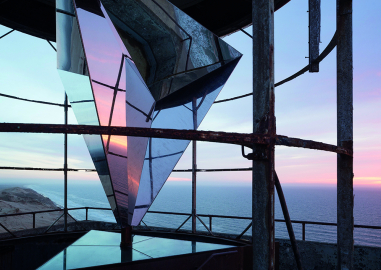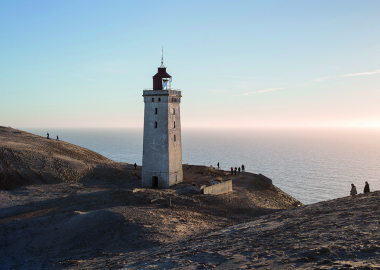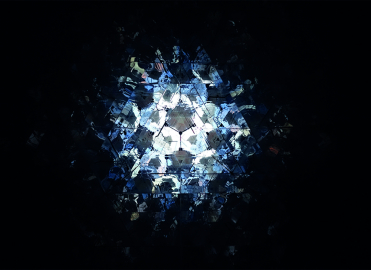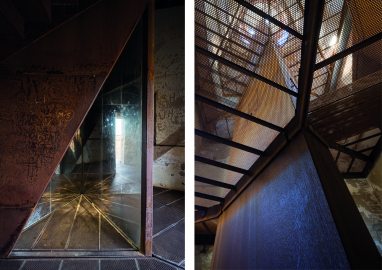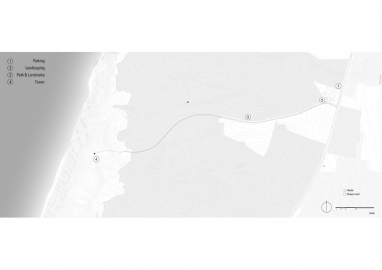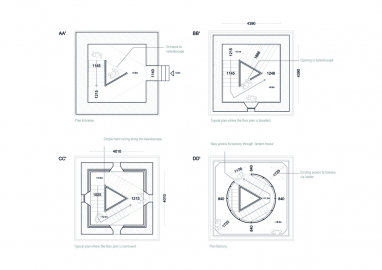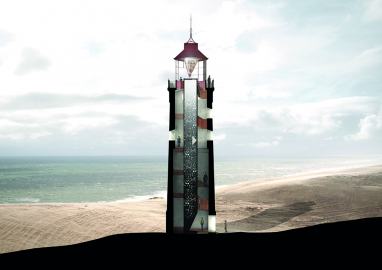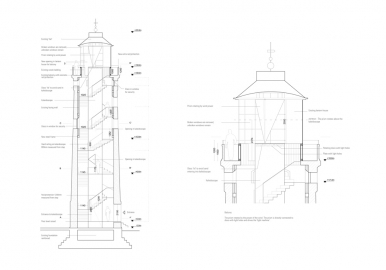Rubjerg Knude Lighthouse
Raging storms constantly shape the dunes on the northwest coast of Denmark. In 1968 a giant sand dune devoured Rubjerg Knude Ligthouse leaving the tower as the only remainder.
The lighthouse was reopened and retrofitted with an architectural installation giving the public a last chance to enjoy the dynamic spectacle of nature from the top of the tower.
BESSARDs’ STUDIO and JAJA Architects designed a scenographic stairway giving access to the tower and making the ascent a sequence of architectural experiences. Staging its historic function as a beacon for the seafarers, they inserted a gigantic wind-powered kaleidoscope into the lighthouse that captures natural light and reflection, sending it inwards to create an ever-changing cascade of colors and glimpses of the sea and surrounding landscape. The kaleidoscope also functions as the structural element on which the stair wraps itself around. The triangular shape of the kaleidoscope in combination with the perforated and transparent stair create a playful interaction with the square geometry of the lighthouse, staging a unique experience of the vertiginous void of the tower, the robust and somehow heroic presence of the massive walls which stretches between earth and sky.
On the site of Rubjerg Knude the ferocious winds from the North Sea blow colossal amount of sand from the cliff into the land. On windy days visitors must endure a continuous sand blast to access the top of the dune and find shelter in the tower and are reminded of the forceful, fascinating and sometimes brutal aspects of nature. The project proposes to add a contemplative experience of the natural forces in presence playfully combining two essential aspects of the site: the wind forming the dynamic landscape of the dunes, and light as the past function of the tower. The architectural installation re-interpret the past function of the lighthouse as a light machine sending light outwards into a dispositive redirecting the natural light inwards into a giant kaleidoscope. The mobile pyramidal prism on the top rotates with the wind and produces an unlimited range of abstract patterns in the kaleidoscope where colors, light intensities, rhythms respond to the pulses of nature.
The simplicity and the robustness of the installation allows Rubjerg Knude to stay open 24/7 opening up for a deep sense of appropriation by the local community and the public.
The project is a variation on the properties of one unique material: steel. Rusted, mirror polished, bent, perforated, welded and finally carefully assembled into a monolith inside the lighthouse. It provides a visual and tactile experience reacting to the extreme meteorological characteristics of the site that creates an aging process that gradually merges the kaleidoscope together with the historic lighthouse. The perforated steel let the natural light penetrate the whole space suppressing the need for artificial lighting and energy sources. The tower was left as far as possible in its existing state of decay leaving the trace of time and the process of erosion and wear dynamic and tangible.
According to geological surveys, the lighthouse will be taken by the sea within the next 2 to 15 years. Nobody knows exactly when the tower will fall but when it will, the project will be entirely disassembled and – thanks to its constructive system – be remounted or recycled.

